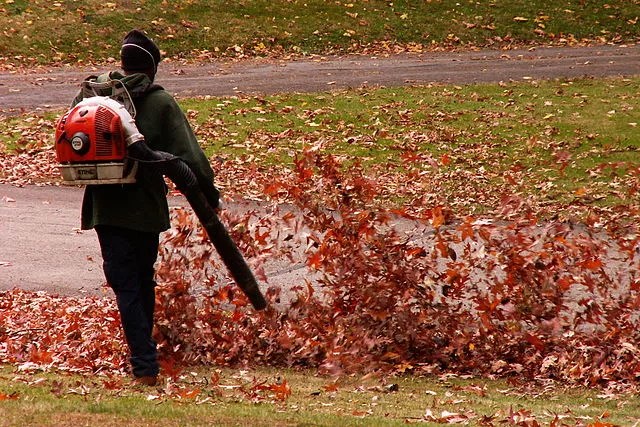

Audio By Carbonatix
Last month, Colorado became the first state in the country to ban certain gas-powered lawn care equipment during the hot summer months, when ozone levels are more likely to reach dangerous heights.
The Environmental Protection Agency has labeled the Front Range of Colorado an ozone nonattainment area because it doesn’t meet national standards for the gas. Ozone is a secondary pollutant that forms when other pollutants – primarily volatile organic compounds and nitrogen oxide – mix with heat and sunlight.
According to a report from the Colorado Public Interest Research Group Foundation, gas-powered garden tools generate around 671 tons of particulate pollution each year in the state, which is the equivalent of what 7 million cars create in a year.
As part of the effort to combat ozone and other air pollution, the Colorado Air Quality Control Commission (AQCC) voted on February 16 to prohibit the use of gas-powered equipment under 10 horsepower by government agencies or on public property along the Front Range between June and August, starting in 2025.
Denver, make your New Year’s Resolution Count!
We’re $13,000 away from reaching our $50,000 year-end fundraising goal. Your support could be what pushes us over the top. If our work has kept you informed and connected this year, please consider making a contribution today.
Affected equipment includes leaf blowers, weed whackers, chainsaws and push lawnmowers. Anything over 10 horsepower, such as riding mowers or tractors, can still use gas to operate.
Although this rule only applies to governments or private companies that have government contracts, the landscape industry knows the transition is coming and is concerned about how it will be managed.
According to John McMahon, CEO of the Association of Landscape Contractors of Colorado, the state was responsive to the group’s concerns, which were reflected in the final rule leaving commercial operators out for now. Originally, they had been considered for part of the ban.
“We’re happy that they listened to us,” says McMahon, whose trade organization represents about 400 companies across the state. “They made some great modifications to what it was originally, so we are supportive that they made those modifications. Are there still some problems? Absolutely.”
The industry’s main two worries are time frame and cost, according to McMahon. He notes that many companies just received new gas-powered equipment within the last year that had been ordered during 2020 and 2021 and was delayed because of parts shortages.
“Typically, the life cycle of that equipment is anywhere between four to six years,” he says. “So in some of these things, it’s having these companies accelerate their need to replace the equipment.”
Additionally, landscaping businesses worry that if they replace electric equipment now, major advances in technology could occur in the next few years, making that equipment obsolete compared to newer items that cost less. McMahon compares the process to electric cars: Early on, there were few, more expensive options, but now there are many options at more price points.
Costs of Going Electric
For the ALCC, the electric landscape market isn’t far enough along for everyone to be able to adapt yet. To replace gas equipment with electric costs about $18,000 per crew or truck, the organization estimates. Companies with many trucks and crews will have to multiply those costs and find locations to charge their equipment with the proper electric infrastructure.
“What that requires is a significant power grid to be able to charge those batteries overnight, and some of those infrastructure costs have been upwards of $100,000, in some cases,” McMahon points out.
Right now, he adds, many companies store their trucks in secure lots without electrical wiring. There are currently federal tax credits for such upgrades, though McMahon says how easily those credits can be accessed by landscape companies is not clear.
However, incentives such as tax credits and grants are the industry’s priority through the transition to electric equipment.
“Our companies do like innovation, they do want to be able to tackle it; we just need the incentives there,” McMahon says. “We don’t want this to be a hardship to the companies.”
Right now, the Front Range’s Regional Air Quality Council has a commercial operator program to help small businesses electrify. There are a few companies in the state that are already voluntarily all-electric, according to the RAQC, and businesses can receive grants of up to $6,000 if they recycle their gas equipment. There is $200,000 available in total business grants for 2024, the council notes.

Parks like Denver’s Cheesman Park will be impacted by the new rules.
Claire Duncombe
Tax Incentives for Small Electric Lawn Equipment
Last year, the Colorado Legislature passed a bill establishing a Colorado income tax credit from 2024 to 2026 for 33 percent of the purchase price of electric lawn equipment. Additionally, that legislation incentivized businesses that sell electric lawnmowers, leaf blowers, trimmers and snow blowers to provide a 30 percent discount to customers by making them eligible for the tax credit on those sales.
The ALCC advocated for those incentive provisions in the bill after it was initially proposed that landscape companies must make the switch.
“I want to also acknowledge that there are some communities out there in some municipalities that are already on that bandwagon,” McMahon says. “They’ve already dedicated money toward that conversion, and that’s great.”
According to the Denver Department of Public Health & Environment, which participated in the Air Quality Control Commission rulemaking, the regulations will benefit both the environment and the health of the workers who currently use gas-powered equipment.
Bill Obermann, who manages the DDPHE’s Love My Air program, says the market is ready for the electric transition with the mainly handheld equipment impacted by this rule. Larger equipment will take more time, he notes, so the 10-horsepower limit is a good fit.
“Our parks department was already buying electrical equipment,” Obermann points out. “This rule makes it required. We embrace that rule. It’s the right direction we need to move in.”

Denver’s golf courses have already swapped its fleet of carts to electric.
City and County of Denver/@denvergolf5280/Instagram
Obermann says that small engines contribute enough to air pollution to make the cost of switching worth it. According to Ryann Money, a communications specialist with the DDPHE, city entities most impacted will be Parks & Recreation, Transportation & Infrastructure, Denver International Airport and General Services.
“Because this is over a year out, there is time to plan ahead to purchase the newer, eligible equipment,” Money adds. “DDPHE plans to work with the Regional Air Quality Council regarding incentives where able.”
Yolanda Quesada, Parks & Recreation marketing manager, says the department is still analyzing the impact of the new rule but had already started converting to battery-powered equipment whenever possible after it finalized the Game Plan for a Healthy City in 2019.
Right now, about a third of the equipment used in park operations besides golf courses is electric rather than gas-powered.
“In regards to Denver Golf, thanks to a grant in 2023 from the Regional Air Quality Council, our gGolf operations made a significant dent in replacing many gas-powered tools and machinery under 10 horsepower,” Quesada explains. “Denver Golf has also transitioned all golf fleet carts to electric and is planning to test fully electric greens mowers in 2024.”
The process will continue under the new rules, and Obermann anticipates “a lot of money” will still be spent replacing the equipment. Thus far, the RAQC has issued nearly $1.8 million in grants for local governments, according to council spokesperson Dave Sabados. However, the grant process for local governments is currently closed while the RAQC seeks more funding.
Lawmakers could add more incentives this year. Senator Barbara Kirkmeyer introduced Senate Bill 24-095, which proposes that the AQCC work with the RAQC to create a garden rebate program for the Denver metro area that would give more rebates to those in the ozone nonattainment area.
Additional regulations could be coming, as the AQCC’s decision on February 16 directed the state Air Pollution Control Division to complete rulemaking that considers restrictions for commercial operators and a possible sales prohibition on new, gas-powered equipment by the end of 2025.
Colorado’s landscapers hope that any new rules will be realistic.
“We welcome cleaner air,” McMahon says. “I think sometimes people think we’re trying to fight clean air. That’s not what we’re doing. We’re just trying to do it with a thoughtful business perspective.”